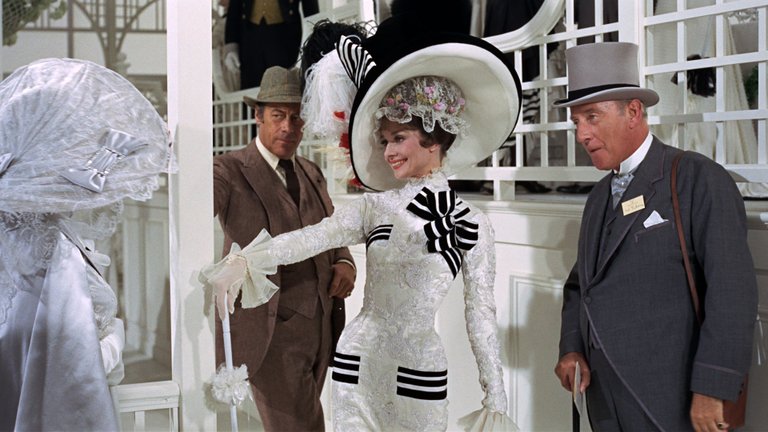Film Review: My Fair Lady (1964)

The 1960s marked a significant period in cinema, yet the general perception of this decade often overlooks the reality of its film landscape. Contrary to the notion that the era was dominated by “hip” avant-garde art dramas or bold experiments like those seen in the French New Wave, the most popular and commercially successful films were, in fact, much more “square” or conventional. Historical epics and musicals reigned supreme, with productions that, apart from their technical advancements and grand scale, bore a striking resemblance to their Classic Hollywood predecessors. A quintessential example of this phenomenon is My Fair Lady, the 1964 Oscar-winning musical directed by George Cukor.
My Fair Lady is an adaptation of the immensely popular 1956 Broadway musical created by Alan Jay Lerner and Frederick Loewe. This musical itself is based on George Bernard Shaw's 1912 satirical comedy Pygmalion, which remains one of his most celebrated works. The film retains the sharp wit and social commentary of Shaw’s original narrative while infusing it with the vibrant music and choreography characteristic of Broadway productions.
Set in Edwardian London, the plot follows Eliza Doolittle (played by Audrey Hepburn), a poor flower seller whose thick Cockney accent catches the attention of phonetics scholar Professor Henry Higgins (played by Rex Harrison). After encountering Colonel Pickering (played by Wilfrid Hyde-White), another phonetics expert, Higgins boasts that he can transform Eliza into a refined lady capable of attending a prestigious embassy ball by teaching her to speak in an upper-class accent. Eliza seizes this opportunity, hoping that her improved speech will secure her a job in a florist shop. With Pickering offering to cover her expenses and Eliza’s father, Alfred P. Doolittle (played by Stanley Holloway), relinquishing parental rights for a small sum, she embarks on an arduous journey of transformation. The months of rigorous training culminate in success when Higgins presents her at Ascot Racecourse; however, his struggle to navigate his feelings for Eliza complicates their relationship.
With a budget of $17 million, My Fair Lady was one of the most expensive Hollywood films of its time. The financial gamble paid off handsomely; not only did it win several Oscars—including Best Picture—but it also became a box office sensation. Its success can be attributed to both its high production values and its ability to resonate with audiences who appreciated its blend of humour, romance, and social critique.
Modern viewers might initially find it challenging to understand why My Fair Lady achieved such monumental success. The film's entirely studio-based production gives it an undeniably old-fashioned appearance when compared to contemporaneous musicals like West Side Story, which had won an Oscar just a few years earlier. However, the answer lies in its rich source material and the formidable talents involved in its creation. The original stage play and Broadway musical were already established successes, ensuring a built-in audience eager for adaptation. Moreover, director George Cukor was one of Classic Hollywood's most respected figures, bringing his expertise to elevate the film further. Additionally, Harrison and Holloway reprised their roles from the stage version, lending authenticity to their performances.
Audrey Hepburn's portrayal of Eliza Doolittle is undoubtedly one of the film's standout elements. At the height of her popularity, Hepburn delivers a remarkable performance as she evolves from a lower-class flower girl into an elegant lady while simultaneously finding her voice against patriarchal figures in her life. Her embodiment of Eliza is both compelling and nuanced; however, this casting choice also highlights a notable flaw in the production process. The producers opted not to cast Julie Andrews—who had originated the role on stage—due to concerns about box office appeal. Consequently, Hepburn's singing was dubbed by Marni Nixon, leading to criticism from fans of the stage musical who felt this decision undermined Hepburn’s performance. Many were disheartened by this choice, particularly since Andrews went on to win an Oscar for her role in Mary Poppins, another iconic musical released around the same time.
A more significant flaw within My Fair Lady lies in its script, which is not particularly economical and contributes to an epic runtime nearing three hours. While some may appreciate the depth provided by lengthy dialogue exchanges and character development, others might find it excessive for a musical narrative.
Despite these shortcomings, My Fair Lady remains an exemplary film that can be recommended not only to fans of musicals but also to those interested in exploring Hollywood's golden age output. Its combination of lavish visuals, memorable music, and sharp wit offers viewers an engaging experience that transcends mere entertainment; it serves as a reflection on social class dynamics that remain relevant today.
RATING: 7/10 (+++)
Blog in Croatian https://draxblog.com
Blog in English https://draxreview.wordpress.com/
InLeo blog https://inleo.io/@drax.leo
Hiveonboard: https://hiveonboard.com?ref=drax
InLeo: https://inleo.io/signup?referral=drax.leo
Rising Star game: https://www.risingstargame.com?referrer=drax
1Inch: https://1inch.exchange/#/r/0x83823d8CCB74F828148258BB4457642124b1328e
BTC donations: 1EWxiMiP6iiG9rger3NuUSd6HByaxQWafG
ETH donations: 0xB305F144323b99e6f8b1d66f5D7DE78B498C32A7
BCH donations: qpvxw0jax79lhmvlgcldkzpqanf03r9cjv8y6gtmk9